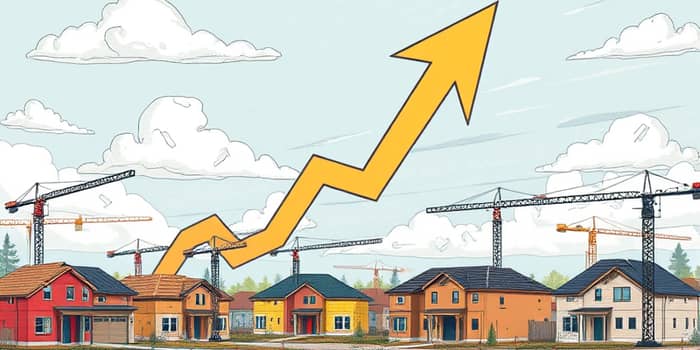
In May 2025, U.S. housing starts plunged to their lowest level in five years as borrowers contended with persistently high mortgage rates and builders reined in new projects. At a seasonally adjusted annual rate (SAAR) of 1.256 million units, starts fell 9.8% month-over-month, missing expectations and underscoring the fragile state of the residential construction sector.
The sharp downturn followed a modest 1.6% rebound in April, when starts were revised up to 1.392 million units. Yet May’s figures fell well short of the 1.36 million units analysts had forecast, representing the lowest pace of groundbreaking activity since early 2020.
Single-family construction bore much of the brunt, with starts sliding from 0.927 million to roughly 0.915 million units, while the multi-unit segment (buildings with five or more units) barely offset losses by edging up 1.2% to 0.341 million. The disparity highlights ongoing persistent affordability challenges for buyers and cautious sentiment among developers.
Regional performance in April—not yet reflected in May’s full data—already hinted at uneven recovery paths. The South and Northeast saw robust activity, while the Midwest and West experienced notable pullbacks.
Meanwhile, April’s single-family starts fell by 2.1%, but multi-unit projects surged 11.1%, reflecting developers’ shift toward higher-density housing to meet demand in suburban and urban markets.
Building permits, a forward-looking indicator of future starts, slipped by 4.7% in April to an annual rate of 1.41 million units. Both single-family (-5.1%) and multi-family (-3.7%) permits declined, suggesting that the structural housing shortage in the U.S. may take time to resolve even as immediate pressures ease.
Late May saw the average 30-year fixed mortgage rate at 6.94%, dipping slightly to 6.79% by late June. Although rates remain below 7% for most of the year, they sit well above the near-record lows of 6.2% reached in September 2024. With experts forecasting rates to “spend most of the year in the 6s,” many potential buyers are sidelined, worried about financing costs and monthly payment increases.
Builders, facing rising borrowing costs and uncertain buyer demand, have pulled back on ambitious projects. Higher financing expenses translate into tighter profit margins, prompting many to delay groundbreaking until lending conditions improve.
Beyond starts and permits, several key trends shape the housing landscape in 2025:
These factors, combined with expansion of inventory supply easing constraints, suggest a shift toward a more balanced market—albeit one still hampered by high rates and economic uncertainty.
Full-year projections for 2025 anticipate approximately 1.35 million housing starts, down from earlier forecasts amid weaker economic growth expectations. Completions are expected to rise marginally, while units under construction could remain below recent highs.
Several headwinds will test the sector’s resilience:
Yet after years of underbuilding, the underlying structural housing shortage in the medium term could catalyze a rebound once rates stabilize and builders regain confidence. For now, stakeholders—buyers, sellers, and developers alike—must navigate a cautious market where financial costs and regulatory dynamics hold sway over construction activity.
As 2025 unfolds, monitor mortgage trends, regional starts data, and permitting activity closely. These indicators will shed light on whether the housing industry can overcome present challenges or if the dip in starts marks the beginning of a prolonged slowdown.
References













